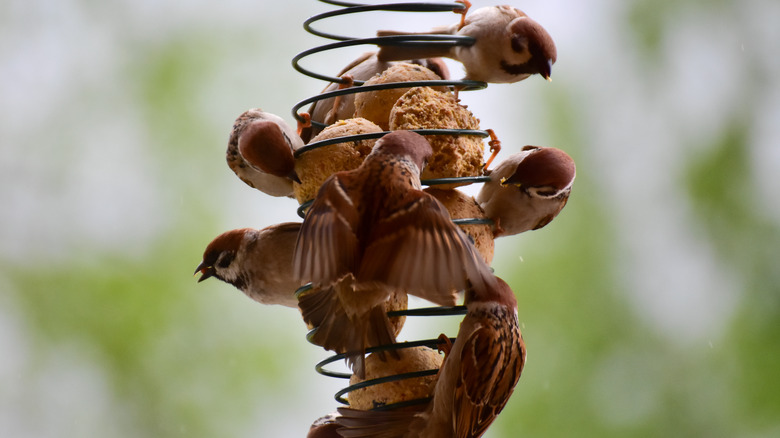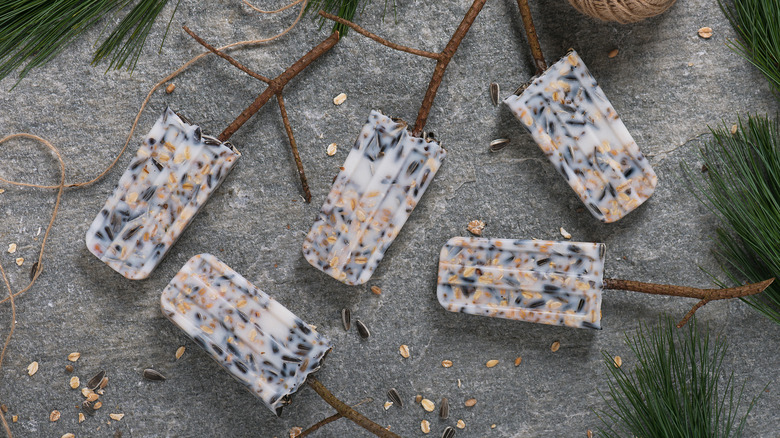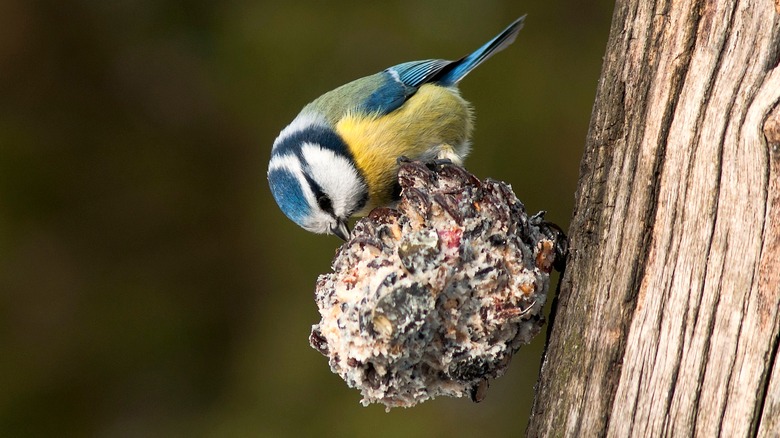Keep Birds Coming To Your Yard Year-Round With These DIY Suet Cakes
Making bird feeders is a simple task. Often, all you need to do is repurpose items that would otherwise be thrown away, such as egg cartons for bringing birds into your yard or transforming old wine bottles into a perfect bird feeder. The problem with standard bird feeders is that while feeding seeds to birds is easy, it's also somewhat messy. Even with the best-designed feeders, you're likely to lose a lot of seeds due to squirrels, raccoons, and the wind. If you want something sturdier that you don't have to replace as often, a suet cake may be the perfect option. Suet involves binding bird food together with some sort of fat, making it fairly resistant to wind and pests.
Putting together suet feeders is relatively easy and may include ingredients you already have in your home. All you need is some sort of fat and food to put in the cake, such as unsalted nuts, dried fruit, seeds, cornmeal, mealworms, or oats. It's a fun craft perfect for getting the whole family involved. Keep it simple by making round little suet balls, or play around with shapes and décor. Birds will flock to these delicious cakes no matter what, so don't be scared to be creative, trying different locations, shapes, and foods with each one you make.
How to make suet cakes
For traditional suet cakes, beef fat is employed, but you can also use pork. There's no need to buy fat specifically for the birds unless you have to. For the most part, this hack is a great way to use fat you've drained from ground beef or bacon that you might have lying around. Basically, you want fats with a melting point of 113 degrees Fahrenheit or higher. Otherwise, it may melt too easily and end up covering a bird's wings, causing them serious harm. The rule of thumb is if you can squish your suet cake, not crumble it; the fat you used is too soft. If you're against using animal fat, natural peanut butter with no added oils is also acceptable.
You may also want a mold of some sort to shape the cake if you don't want to use your hands. A small donut mold, Bundt pan, coffee cup, popsicle mold, or cupcake tin are all options. Once you have your fat of choice and a mold, all you need to do is melt it down to a liquid. Once melted, pour it into a mold, add in your seeds, nuts, and fruits of choice, and let it dry. When it cools and solidifies, stick the suet cake in a suet bird feeder. You can also tie some string on the cake and hang it from a nearby tree.
When to use suet cakes
Because of how they're made, suet cakes are high in fat. While they work at all times of the year, they are best in the middle of winter. When it's cold out, birds need more energy to stay warm, so high-fat foods are the best at this time of year. Plus, the cooler temperatures mean the fat stays solid longer and doesn't go bad as fast. Never use suet cakes in warm temperatures above 80 degrees Fahrenheit or so, especially in the sun, or else you risk the fat melting or rotting. If you smell a rancid odor near your suet feeder, it's time to replace the cake.
When using suet, you'll attract certain birds more so than others. Chickadees, nuthatches, jays, starlings, creepers, cardinals, and woodpeckers all enjoy suet feeders. Depending on what ingredients you mix into the suet, you may attract more of one type of bird than another. One of the common bird species you don't want to see at your bird feeder is the red-winged blackbird due to its bullying antics. Suet cakes come in handy here, too. Because these annoying birds often prefer the high-fat content of suet cakes to plain bird seed, you can set them away from your feeders, allowing small songbirds to congregate at the seeds while you distract the more annoying species.


